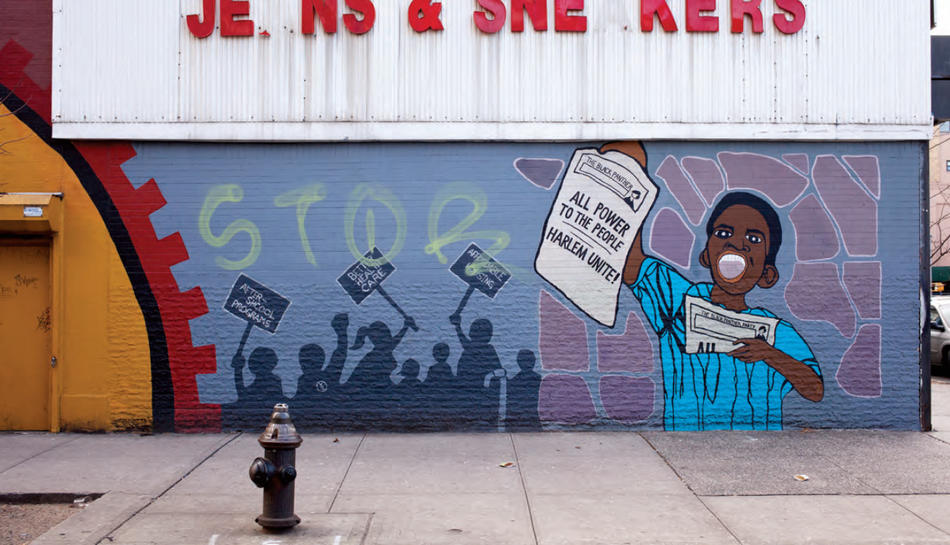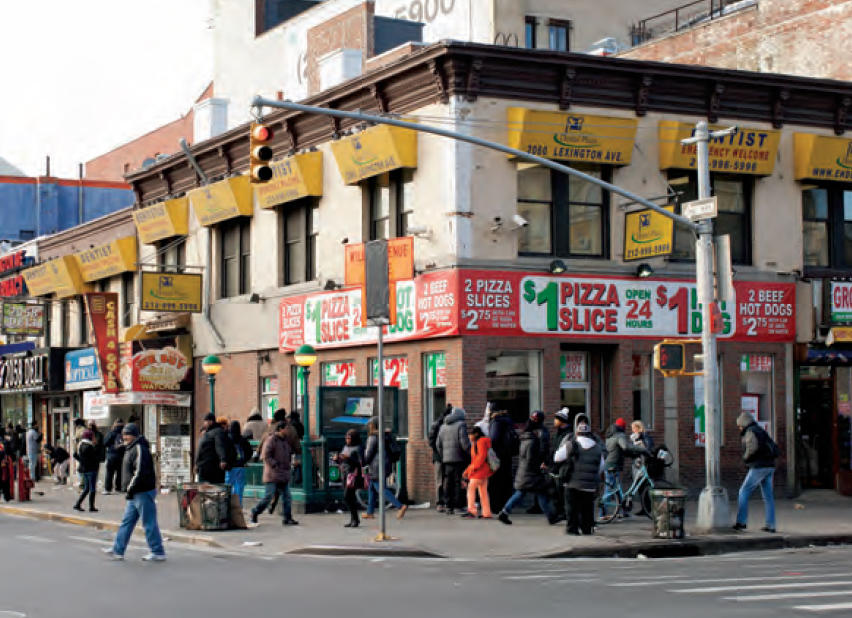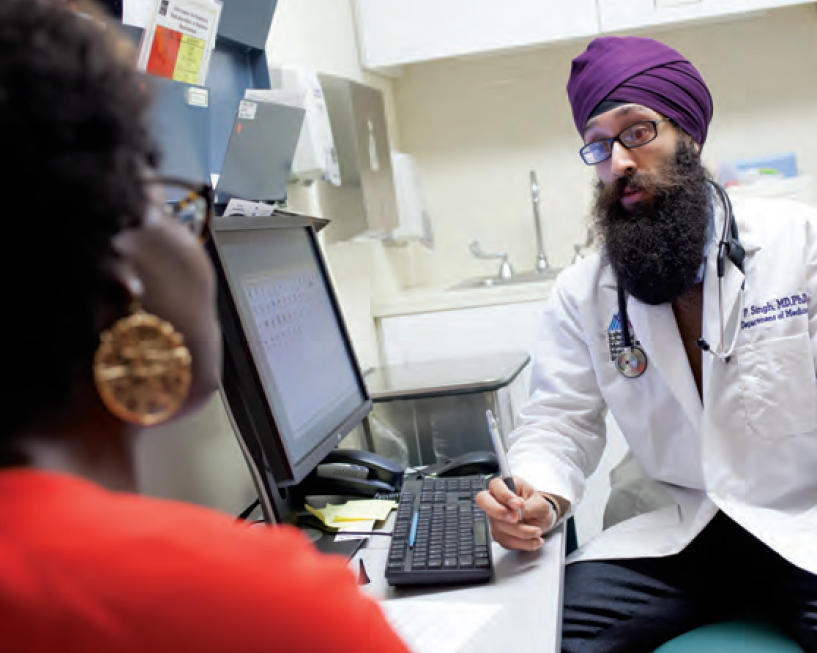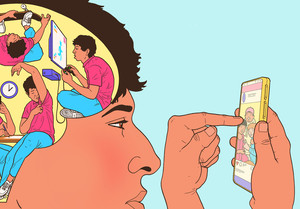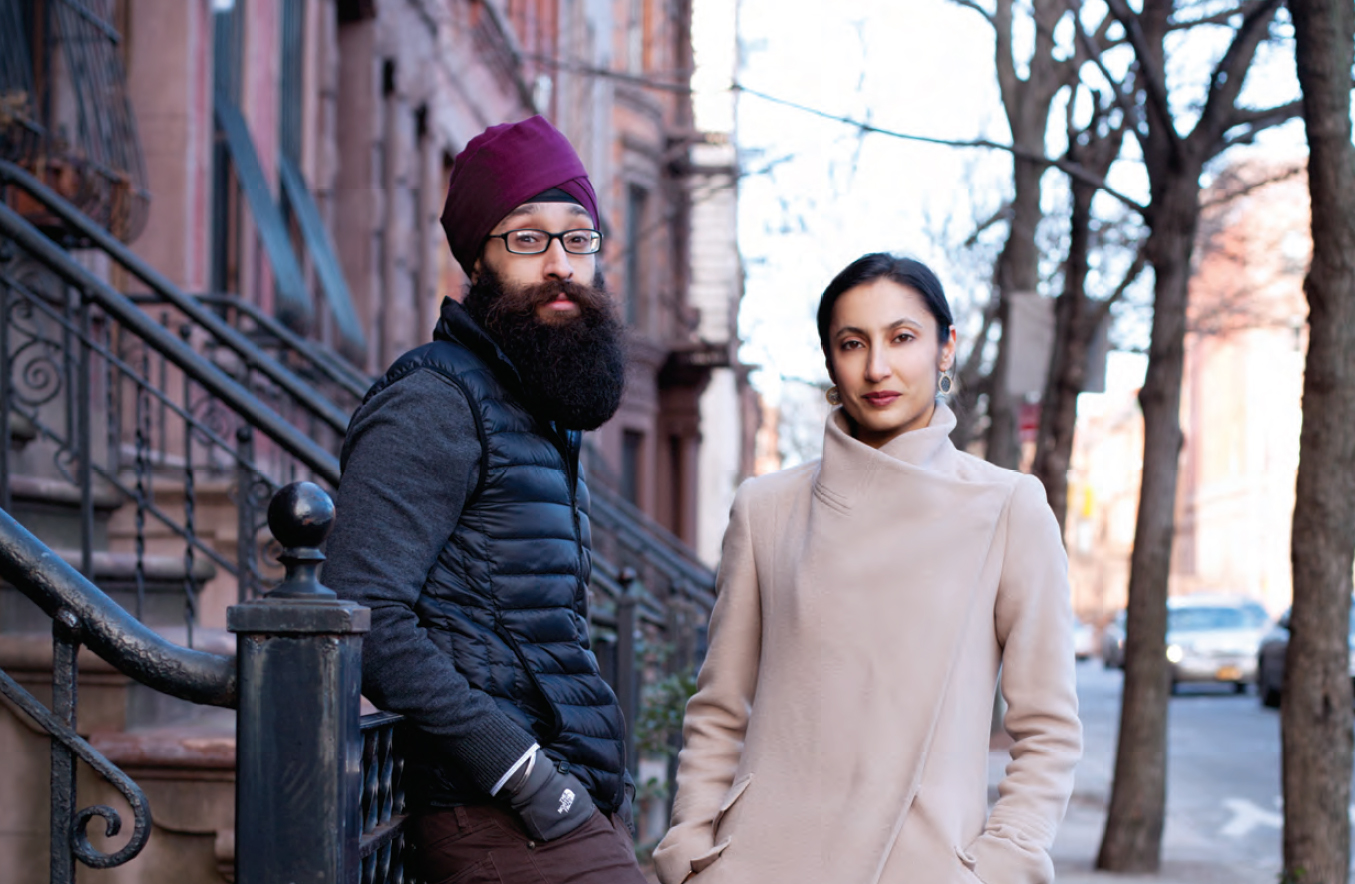
When Manmeet Kaur and Prabhjot Singh moved into East Harlem in 2010, the health crisis there had long been dire.
Seven years earlier, the Journal of General Internal Medicine published an article stating, “The toll diabetes takes on residents of communities of color, such as East Harlem, is staggering ... Hospitalizations among persons 65 years and older for diabetes-related amputations in this neighborhood are nearly 5 times those for NYC overall.” In 2007, the New York State Health Foundation reported that East Harlem residents are hospitalized for diabetes at a rate ten times that of people on the Upper East Side. In 2006, N. R. Kleinfield of the New York Times, covering diabetes in East Harlem, wrote of “the human behavior that makes dealing with Type 2” — the common form of diabetes, in which the body cannot produce enough insulin to maintain a normal blood-sugar level — “often feel so futile — the force of habit, the failure of will, the shrugging defeatism, the urge to salve a hard life by surrendering to small comforts: a piece of cake, a couple of beers, a day off from sticking oneself with needles.”
Despite this attention, the problem only worsened. ‘DIABETES EPIDEMIC’ DECLARED AS NEW YORK CITY DEATHS TIED TO THE DISEASE HIT ALL-TIME HIGH, ran a New York Daily News headline in June 2013. Around the same time, the New York City Department of Health and Mental Hygiene found that 667,000 New Yorkers have diabetes — a 33 percent increase from a decade ago. And East Harlem (population 108,000), half Latino, a third African-American, with an influx of professionals, mostly white, filling the new residential buildings — a neighborhood of high obesity rates and gang activity, where 38 percent of residents live below the poverty line — is New York’s diabetes epicenter: as many as one in five people here has the disease.
For Kaur ’05BC, ’12BUS and Singh, a SIPA professor, this quiet catastrophe points up a fatal failure in the US health-care system. It also presents a bold opportunity.
Two women from East Harlem sit facing each other inside a large room with a mirrored wall in a Mount Sinai Medical Center clinic on East 94th Street.
“I had a horrible day,” says the younger woman. “Half the day I was feeling drowsy, irritable, dizzy, confused. I don’t like to check my glucose but once a day, so I didn’t even check it after that.”
“You know that when the doctor prescribes your insulin,” says the older woman, her voice gentle and firm, “he prescribes for you to take it just before you eat.”
A sigh. “I know, but sometimes I get thrown off schedule.”
“Yeah, I understand. We all get busy, and life doesn’t wait for us. But be careful, because there can be a lot of side effects, like you felt last night.”
At a long table, a small group of community-health workers, called coaches, observe the two women, who are also coaches. Led by nutritionist and diabetes educator Jamillah Hoy-Rosas, the coaches are rehearsing for the real-life encounters awaiting them outside.
“I don’t wanna feel like that no more,” says the younger woman. “Is it because I doubled up?”
“Yes, it’s because you doubled up. Then you didn’t eat. When you double up on your insulin you’re gonna feel bad, and it could be dangerous.”
Hoy-Rosas takes notes. She’s the clinical care manager for City Health Works, a nonprofit community-health organization started by Manmeet Kaur. Prabhjot Singh is the lead adviser. Last September, in the shadows of the impending government shutdown over opposition in Congress to the Patient Protection and Affordable Care Act (ACA), City Health Works began a pilot project to demonstrate its approach.
It’s October now. As the shutdown enters its second week, the machinery of health reform cranks forward. The ACA has accelerated a fundamental shift in financial incentives, supporting innovations in payment and delivery that reward quality of care over quantity.
“Traditionally, doctors and hospitals have been paid on a fee-for-service basis,” explains Kaur, thirty, seated in the City Health Works office at the East 94th Street clinic. “The insurer pays the doctor or clinic for each visit, each test, each screening. But the fee-for-service structure hasn’t improved outcomes or controlled costs.” The office has peach walls, filing cabinets, carrels, nutrition posters. “Hospitals have never been incentivized to care about wellness and prevent illness,” Kaur says. “They profit if you’re sicker.” She chuckles. “This is at the heart of why the system is so perverse.”
At City Health Works, Kaur and Singh have zeroed in on a critical gap in the health-care system: a lack of access to primary care in low-income areas. This gap has always been a reality for patients, but now, for the first time, doctors and hospitals are feeling the financial effects. “Health reform is saying, We’re not going to pay for all these people that are bouncing back over and over again,” says Singh, thirty-one. He notes that the fee-for-service model is being replaced by strategies like global payments, in which hospitals manage the risks of all of their patients with lump sums: if they do it for less, they save money; if they do it for more, they lose money. “So there’s a massive incentive,” he says, “to build this community-health infrastructure.”
Singh is the director of systems design at Columbia’s Earth Institute and teaches a course on global health practice at SIPA. He is also a physician at Mount Sinai Medical Center and co-chair of the One Million Community Health Workers campaign, an Earth Institute –based initiative of the African Union and the UN Sustainable Development Solutions Network. (The goal: one million health workers for sub-Saharan Africa by 2015.) He wears a burgundy turban, a long, black beard, a forest-green pullover, and designer jeans.
“Three or four years ago, the attitude of the New York health systems was, We don’t want to deal with community health. It’s such a money loser in this fee-for-service system,” Singh says. “That flipped immediately” — he snaps his fingers — “when health reform kicked in. Now there was a thirty-day readmission penalty: if patients came back before thirty days and you treated them, you wouldn’t get new money. Suddenly, doctors said, We’d better build a system to take care of people for thirty-one days.
“But what about the rest of the year? Why not make a system that takes care of people for 365 days, and not have them just come in and out of the hospital?”
“There’s a need,” says Kaur, “for a much more intensive community- based layer of the health-care system. Behavior changes are complicated. Socioeconomic factors that cause stress and influence health cannot be solved in a doctor’s appointment.”
Singh can attest. “As a primary-care physician, I know that in my fifteen-minute visit with a patient, I’m not equipped to give life coaching. And I’m not the guy to do it. So we’ve hired residents of East Harlem who are gifted motivators, trained in motivational interviewing techniques, who help people set goals around diabetes care, around living a healthier life.”
For the moment, the coaches are paid for with grant money from the Robert Wood Johnson Foundation and a service fee from Mount Sinai, New York’s largest private-hospital system. Kaur and Singh are working with insurance companies so that, over time, insurers will join the hospitals in financing the coaches.
“Our goal for this pilot,” says Singh, “is to get sustainable payments so that we know the pricing for the system. We’re figuring out all the connections, all the costs.” Singh and Kaur believe that their model will lower expenses for everyone: patients, hospitals, clinics, and insurers. “As that happens,” Singh says, “then this can spread.”
It’s about a thirty-minute walk from City Health Works to the high-rise condo at Fifth Avenue and East 120th Street. That path, which traverses the lower half of East Harlem, is checkered with fast-food joints, tenement walkups, and columns of the stark, huddled red-brick towers of the New York City Housing Authority.
Crossing East 96th at Third Avenue on a Friday afternoon, you pass the Mecca-facing domed mosque of the Islamic Cultural Center of New York, toward whose open doors flows a stream of men and boys in caps and tunics. Outside the gates, a South Asian woman in a chicken curry, telling a health-curious customer that meat is a necessity, which prompts a bearded, taqiyah-wearing man to suggest, in a barrio accent, that vegetarianism and bottled water are the way to go (he’s not there yet himself). Three blocks north, a food stamp–friendly greenmarket offers broccoli ($1.50/lb.), collard greens, snap peas, turnips, kale. Three elderly Puerto Rican women watch a stir-frying demo at an adjacent booth (broccoli and parsnips, olive oil, low-sodium soy sauce). The market, open on Fridays from April to November, is run by Harvest Home, a nutrition-minded nonprofit that receives support from EmblemHealth, New York’s largest private health insurer. EmblemHealth’s purple-on-white emblem is conspicuous here, and vans bearing the logos of other insurers cruise the area, competing for customers. So it makes a kind of thematic sense that when you turn and look west on East 99th Street, you see, half a mile away on Madison Avenue, looming like an obsidian monolith in a fantasy novel, the 434-foot black edifice of Mount Sinai Medical Center.
On Third Avenue, meanwhile, the food plot thickens: we have, clotted together, McDonald’s, Little Caesar’s, KFC, Burger King, Taco Bell, Dunkin’ Donuts, and, in a few groceries, modest arrays of apples and fresh vegetables that can’t shout like the playroom reds and yellows of the busy fast-food chains that saturate the diabetes epicenter of New York. Turn left at 110th (Tito Puente Way), walk under the elevated train at Park Avenue, past the Lehman Village Houses to the traffic circle at Fifth Avenue, where the future home of the New Africa Center rises above the northeast corner of Central Park. Below, in the autumn-mellow park, on a green-skinned lake, brown ducks paddle with their bills open, munching the algae-colored, protein-rich duckweed. This is where East 110th Street becomes Central Park North.
If you turn right on Fifth Avenue, you’ll pass the Harlem Academy; the Martin Luther King Jr. Towers; the fire-engine-red garage doors of Engine 58/Ladder 26, where a banner reads, Proud home of FF. Mike Corrigan, currently on active military duty with the US Army in Afghanistan. Freedom is not Free; and low-rise residential buildings and storefront churches that march up to the schist outcropping at 120th Street, which marks Marcus Garvey Park (called, before 1973, Mount Morris Park, the name preferred by today’s realtors).
Kaur and Singh live across from Marcus Garvey Park with their one-year-old son, Hukam. They have lived there for three years.
“I hear it every day,” says Leny Rivera, a Honduran-born New Yorker who lives on East 109th Street. “Neighbors talking about struggling with diabetes.”
Rivera was the first coach hired by City Health Works. Like the newer trainees, she has learned a counseling technique called motivational interviewing, in which, Kaur says, “you don’t tell people what to do, but guide them into identifying their motivation and their sources of ambivalence.”
“The biggest challenge,” says Rivera, “is food. Our parents raised us on certain foods, and we got accustomed. The members” — members being the term for people in the City Health Works network — “are mostly Puerto Rican and Mexican. They eat a lot of deep-fried foods. So instead of cutting things out entirely, we minimize: try it for a week and see how you feel. We’ve had some success, but it goes back and forth.”
Once a week, Rivera walks to the food pantry at Madison Avenue and East 109th to meet with members one-on-one. She has six members, all diabetic, all older, all from the neighborhood.
“You hear a lot of life stories,” she says. “People don’t have a lot of support. Low income. No insurance. They’re not being treated and have nowhere to go. When they hear about a program to help them, they are very grateful.”
Rivera emphasizes diet and physical activity, and encourages members with untreated ailments to see a doctor before the problems get bigger and more expensive.
Singh puts it this way: “You go to the doctor one day out of the year. Where’s the health-care system for 99 percent of your life? That’s what’s missing, and that’s what we’re feeling. Clinical care accounts for only 20 percent of health outcomes. Thirty percent comes from health behaviors, 40 percent from your socioeconomic circumstances, and 10 percent from your physical environment. Yet we spend trillions on that first 20 percent. We’ve bet the farm on this hospital-heavy model. It’s like a sinkhole: you have to get bad enough to warrant medical care. But the time between when you feel a symptom and when you get really sick can be pretty long. And you’re kind of left to the wolves.”
This, says Singh, is where we can learn from other systems — for instance, the notion that entrusted people from neighborhoods can play an important role in people’s health, as he found in sub-Saharan Africa. There, community-health workers, strongly supervised and equipped with mobile phones, deliver items like antimalarial and antidiarrheal treatments.
“At a time in the US when we’re worried about costs,” says Singh, “when we’re not delivering high-quality care, when we’re not reaching vulnerable populations, there’s much we can learn from those systems abroad, and bring it to places like Harlem.”
On Saturday, September 21, 2013, members of the Somalia-based Islamist group al-Shabaab carried out an assault-rifle attack on the Westgate Mall in Nairobi, Kenya.
For Prabhjot Singh, this was no far-flung event. He had spent his early childhood in Nairobi, part of a relatively prosperous and cohesive Indian community of 70,000 that, between the British colonizers and the black African majority, had always lived a little uneasily in Kenya. Singh had been busy that day finding out if his relatives, who lived minutes from Westgate, were OK. They were.
That evening, in New York, at sundown, Singh and a friend took an after-dinner stroll along Central Park North. Minutes earlier, Singh had dropped off his wife and son at home. Now, walking on the park side of the street, he approached the T-intersection at Malcolm X Boulevard, with the park on his left and Central Harlem fanning out to his right. It was a mild night; people were about; Singh saw a family walking ahead of him.
“Osama!” came a voice from behind. “Terrorist!”
A hand grabbed Singh’s beard. A fist caught his jaw. Singh stumbled and ran.
He ran, and behind him he saw bicycles. Fifteen or twenty bicycles, ridden by what looked like teenagers. “Osama!” “Get him!”
The bikes quickly overtook Singh. More fists flew at him. Singh fell to the ground, and was surrounded.
Manmeet Kaur had just returned to New York after three years abroad on a human-rights fellowship when a friend invited her to a party. Her name was Manmeet Kaur Bindra then.
It was August 2008. At the party, her friend introduced her to a brilliant young Cornell medical student who was getting his PhD in neural and genetic systems at Rockefeller University and working with the Columbia economist Jeffrey Sachs on the healthcare component of Sachs’s antipoverty Millennium Villages Project. Days earlier, as part of a new spiritual commitment, he had stopped trimming his beard.
Kaur was familiar with that practice. Her grandfather was a famous Sikh scholar in India, at Panjab University. She was devoted to him. Though she grew up in Baldwin, on Long Island, she got to visit her grandfather several times in India and in America. His name was Harnam Singh Shan. All baptized men in the Sikh faith take the name Singh, meaning “lion.” Baptized women take the name Kaur, which means “princess.” Though Kaur was secular at the time, she and Prabhjot Singh were strikingly well-matched. Here she was, the daughter of Sikh Indian immigrants, preoccupied with labor issues at an early age, having worked weekends and summers in her parents’ dry-cleaning shop. There, she got to know the immigrant workers, listening to their stories about crossing the border. As a child worker, she gained further insights. By high school she wanted to be a human-rights lawyer.
She earned a degree in anthropology and history from Barnard, where she won a Third Millennium Foundation human-rights fellowship that began after graduation. Her first stop on the fellowship was South Africa, where she worked with, and was inspired by, Mamelani Projects, a community-health group whose outreach method took into account factors like the patient’s employment situation and home life. For the fellowship’s second half, she went to India and eventually got involved with LabourNet, a social enterprise in Bangalore that functioned as an intermediary between construction workers and employers. The idea was to improve worker standards, not through the labor-union method of negotiating contracts (the construction industry in India is around 80 percent informal), but by educating workers in health and finance and helping them get insurance that would move with them from job to job.
These experiences gave Kaur a sense that, when it came to implementing better living standards for people, the power of the law was limited. What she really wanted now was to create programs that could change whole systems.
And here he was: Singh, too, was a systems person. A systems scientist. He, too, was raised in a casually practicing Sikh household. He left Kenya at age eight, when his father, amid growing violence against Indians, moved the family from Nairobi to East Lansing, to do his postdoc at Michigan State. Afterward, the family migrated to Bucks County, Pennsylvania, where Singh — Prabhjot Singh Dhadialla then — finished high school. Since 2005, he’d been going to rural parts of sub-Saharan Africa and India, learning how people living in severe poverty built their own health networks and delivered care.
He, too, wanted to change whole systems. Build better ones.
“Would you like to meet for lunch?” Singh said.
Kaur and Singh met for lunch. Ten weeks later, they were engaged.
They got married in October 2009. Kaur embraced Sikhism, dropping her last name, Bindra, just as Singh had dropped Dhadialla. She began working for the Earth Institute, traveling to East and West Africa to consult on the financing and management strategies of the Millennium Villages project’s health-care workforce, both at the community-health level and in village clinics.
It was then that she began thinking about starting a community-health program in New York. What she needed was some business knowledge. A business plan. She applied to Columbia Business School, and got in.
On the evening of September 21, Kaur came home from dinner and got her baby ready for bed.
This was an exceedingly busy time for Kaur. The pilot project had started just days before, the culmination of three years of planning and fundraising, during which Kaur had taken time off to give birth to Hukam. After she returned from maternity leave, in December 2012, she hired a director of operations, Donya Williams, then spent the first quarter of 2013 cultivating relationships she had begun in B-school. It was back then, through her classes in the Social Enterprise Program, that she had gone into the neighborhood to meet people from community organizations, schools, food pantries, and churches. She’d wanted to know: was there a need in East Harlem for a program that hired and trained people from the community to coach their peers to prevent and manage chronic diseases? Kaur had found that there was.
Through the Entrepreneurial Greenhouse Program at the B-school, she met with philanthropies, making the case that high-risk patients, and especially those with chronic conditions, rarely saw doctors or knew how to manage their own ailments. She had a plan to change that.
Two major funders came through: the Robert Wood Johnson Foundation and the Robin Hood Foundation. Then Mount Sinai offered a service contract, paying City Health Works $100,000 for 2013, with $120,000 allotted for 2014. Now, the nonprofit had to prove itself.
As Kaur set Hukam in his crib, her phone rang. The caller, she saw, was her husband’s walking companion. She answered.
The friend was calling from the street on Central Park North. He told Kaur that Singh had been attacked by a large group of young men on bikes. The youths punched him, knocked him down, and kicked him repeatedly. Thankfully, some passersby — an elderly man, a nurse from St. Luke’s, and one or two others — intervened, scattering the assailants and preventing a bad situation from getting far worse.
Kaur was frightened, worried. But she wasn’t shocked. Singh had been assaulted in 2003 and 2005, though not as badly. The possibility of violence was a daily fact.
Kaur’s worries only grew when she looked down at Hukam. In a few years, he, too, would have a turban on his head. Every Sikh man Kaur knew had been bullied, harassed, intimidated. What kind of world awaited her son?
She got a babysitter and rushed to the emergency room at Mount Sinai, where Singh lay on a bed, bruised and bloodied. His jaw was fractured, his teeth knocked loose. Kaur held her husband’s hand.
The next morning, Kaur and Singh rented a car and drove up to Albany, where Kaur had a family friend who was a maxillofacial surgeon. Singh’s teeth needed to be stabilized. It was only by a family connection that Singh was able to receive, on a Sunday, immediate, first-rate care.
That same day, Simran Jeet Singh, a PhD candidate in Columbia’s Department of Religion and a close friend of Prabhjot Singh, wrote a piece for the Huffington Post titled “Hate Hits Home.” In it, he described what had happened to Prabhjot — and what had happened to thousands of Sikhs across the country since September 11, 2001. Prabhjot Singh, a wire in his jaw, was hardly alone.
Simran Singh’s article circulated fast. As Kaur and Singh drove back home from Albany on Monday, the phone calls started. Media requests. Reporters in the lobby. Cameras.
The attention was intense and new for the young couple. But there was no question about how they would handle it.
The convergence of social elements — Sikh doctor/Ivy League professor is attacked in Harlem by a group of African-American teens shouting “Osama!” — offered news outlets from New York to Delhi any number of story lines. Some found it poignant that Prabhjot Singh and Simran Jeet Singh had, a year earlier, coauthored an op-ed in the New York Times called “How Hate Gets Counted,” in response to the August 2012 handgun attack on a suburban Milwaukee temple that left six Sikhs dead before the white-supremacist shooter turned the gun on himself. Singh and Singh argued that the tendency of law enforcement and the media to portray the numerous attacks on Sikhs as cases of mistaken identity intended for Muslims ignored the history of violence against American Sikhs over the past hundred years. They called on the FBI to begin tracking anti-Sikh violence.
Now, a year later, Prabhjot Singh spoke out again, this time in the September 24 edition of the Daily News. “Even more important to me than my attackers’ being caught is that they are taught,” he wrote. “My tradition teaches me to value justice and accountability, and it also teaches me love, compassion, and understanding. This incident, while unfortunate, can help initiate a local conversation to create greater understanding within the community.”
Kaur added her perspective on the news website the Daily Beast: “In the Sikh spirit of chardi Kala (joyous spirit), and as the mother of our one-year-old boy, I want to work with our neighbors, local and global, to help create an environment in which our son has nothing to fear. My husband and I both live and work in Harlem and have devoted our careers to addressing conditions of poverty that are often drivers behind sad events like this.”
These responses brought fresh attention to Singh as the enlightened doctor who, in the face of hatred and violence, had sounded a healing note.
A week after the attack, Singh came downstairs from his apartment to meet a reporter. He was still in pain, but recovering. In the lobby, the concierge, an offensive-tackle-sized Latino man, seeing Singh for the first time since the incident, approached him with open arms and an expression of regret-filled sympathy.
“Dr. Singh,” he said, and drew the frail-looking physician into an embrace. “I’m so sorry for what happened. I got your back, Dr. Singh. I got you.”
“Thank you,” said Singh. “Thank you.”
“I apologize for those kids. If I had been there —” The concierge broke off.
“It’s OK,” said Singh.
Later, upstairs, seated on an orange couch in a sunny, white-walled room, Singh cleared up a misconception about his religion that had been swirling since his statements.
“On a public basis, there has been a strong emphasis on the peaceful orientation of Sikhism,” he said. “Although that’s foundational, an important part of Sikhism is that, in order to keep peace and pursue justice and equality for all — not just for Sikhs, but for humanity — it is crucial to engage in appropriate force when necessary.
“Sikhs have had a long military history of serving with the British, with the Allies in World War II, their own resistance in the 1500s against the Mughal armies, and of defending Hindus from mass Islamic conversions in India. This is part of an oral tradition that we grow up with: how to comport yourself in times of duress in an ethical manner.”
Singh stressed that his own response shouldn’t necessarily be a model for others who have endured such an event.
“If someone went through this and feels angry or upset, I would never rob that person of his or her authentic emotions. If you’re upset and you’re hurt and you haven’t had time to process it, I would not, as a physician, say, Pull up a smile and get out there.
“The difference with us is that we are so embedded here. And we’re fortunate to be part of such incredible resources that allow me to feel that I can do something, that there’s a meaningful way forward. There is no need for me to rattle my saber simply because I can. Rather, I have to think about the fact that I’m going to be working in the same place, with the same people. So it’s not just a moment of errant generosity. It’s that we have a lot of work to do and we are doing it.”
The two coaches in the clinic finish their role-playing exercise. At the long table, Hoy-Rosas and the other coaches praise the older woman on her empathy and confidence. Hoy-Rosas then offers a critique.
“What I’d really liked to have seen here,” she says, “is some discussion of how the member was feeling, because the symptoms she had are basically hypoglycemia. Her sugar’s going to be low. I’d like to have seen encouragement for her to check her blood sugar the next time something like that happens, and a little education around what to do: ‘If that happens again, it’d be great if you checked your blood sugar. And if your sugar is lower than seventy, take a one-carb snack.’ That’s a teachable moment right there. She did something she shouldn’t have done, she had a negative consequence: that’s a beautiful teachable moment. We don’t want to miss those.”
The essential building blocks of Sikhism are oneness and love,” says Simran Jeet Singh, the PhD candidate in religion, who was born in San Antonio and earned his master’s degree at Harvard. “Every action that a Sikh takes is inspired by love and the intention of creating unity in the world.”
Singh names the three core precepts of the religion: Naam Japna (remember the divine), Vand Chakna (share your gifts), and Kirat Karna (live ethically and work honestly), saying, “The Sikh religion places emphasis on spiritual development and social contribution. We’re taught that loving worship is expressed through service, and Sikhs constantly try to integrate service into their professional work.”
Sikhism is a monotheistic, egalitarian religion (the assigning of “Singh” and “Kaur” was meant to erase the caste signifiers encoded in surnames), founded by Guru Nanak around the year 1500 in the Punjab. Nanak decried the conflict between Hindus and Muslims, and preached a message of equality and unity, gaining followers called sikhs, or disciples.
“Guru Nanak set the precedent for how to live our lives,” says Simran Singh. “He constantly served those around him, and focused especially on serving people in need. Sikhs have long developed institutions that help underprivileged communities with all types of basic necessities, from food and shelter to education and medical attention.”
There are twenty-five million Sikhs worldwide, mostly in the Punjab, and about 500,000 in the US. As Prabhjot Singh points out, “99.9 percent of people with beards and turbans in America are Sikhs.”
“It was an uninviting block, treeless and barren, lined with soot-colored walk-ups that cast heavy shadows for most of the day,” wrote a future US president in his 1995 memoir, Dreams from My Father.
That description of East 94th Street between First and Second Avenue mostly holds, save for the bright blue awning of the Mount Sinai clinic. Thirty years after Columbia undergrad Barry Obama sat on his fire escape to smoke cigarettes and “study the dusk washing blue over the city,” the work being done on this block may influence the future of President Obama’s landmark legislation. It was here that the student Obama got the phone call from Kenya about his father’s death, and it is here, now, that a doctor with roots in Kenya and India is bringing from Africa the dream of the healing power of community. Singh and Kaur know how real that power is.
At City Health Works, the coaches have finished their training and are working full-time. There are six coaches in all, and together they will be responsible for managing the goal-setting game plans of five hundred people.
Almost two months after his assault, Singh has regained his vigor, even as he continues to go through “heavy orthodontics.” His assailants are still at large. As the investigation continues, so does Singh: he meets with students, sees his patients, works on his local and global health-care endeavors. In mid-November, Singh and Kaur spend the holiday of Guru Nanak Jayanti — the birthday of Guru Nanak — with Simran Singh at the Richmond Hill gurdwara, or temple, in Queens.
“Growing up, I didn’t really have strong ties with the Sikh community,” Kaur says. “Prabhjot didn’t either. In the past, this response we’ve seen for Prabhjot couldn’t have happened, because we didn’t have much of a sangat, which in Sikhi is a community. Sangat is a really important part of our religion: having this community that you work with, that you do service with. We have that now.”

